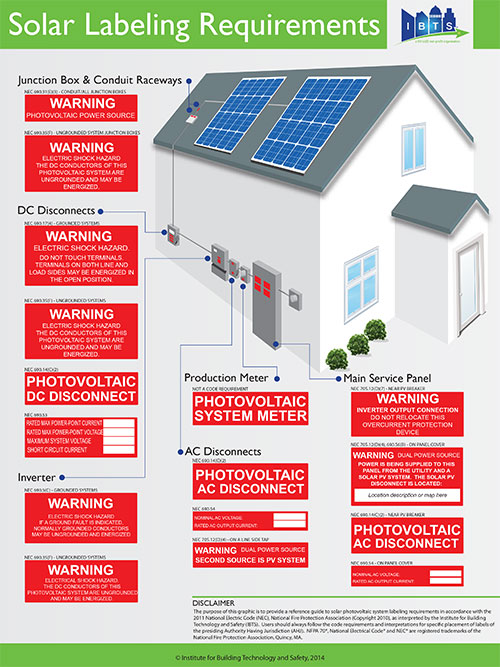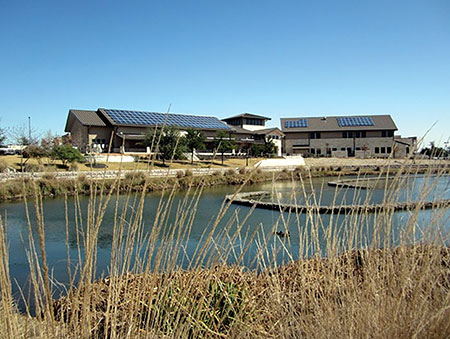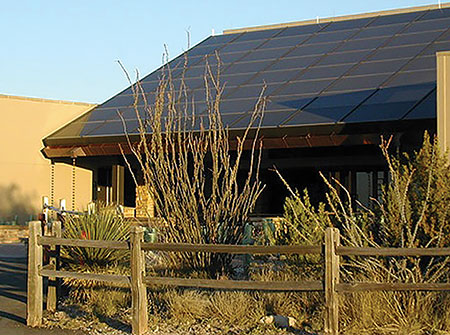Where were you when _____? Most of us know exactly where we were, who we were with, and what our first thoughts were as major events of our lifetime unfolded. Was it this impactful when the news hit the streets earlier this year that the U.S. reached the one million mark for residential and business solar PV installations? Probably not. But maybe it should be.
If you are reading this article, either your days are touched in some way by the exploding PV industry, or you know it is only a matter of time. Whether you are an electrical or building inspector, a general contractor, a PV professional or an educator, the fast pace of this evolving industry can either keep you up at night or be the morning jolt you need with (or in lieu of) that first cup of caffeine.

To keep up, professional training is critical.
So is communication.
The importance of updated technical training goes without saying. IAEI’s ongoing partnership with the Interstate Renewable Energy Council (IREC) continues to make this easier and more effective than ever, through a newly updated, interactive online course designed for code officials, referred to as PVOT (PV Online Training). The course is free of charge, lauded as “exceptional” by industry experts and your IAEI peers who have completed it, and offers CEUs from the IAEI, the International Code Council (ICC) and NABCEP (North American Board of Certified Energy Professionals).
While the course was originally designed for code officials (by a prestigious working group of subject matter experts and under the guidance of IAEI and IREC), it is increasingly utilized by electrical and general contractors, PV installers, and others who can benefit from the knowledge in a self-paced, online format. Think of it as another piece in your professional toolbox.

— Download Solar Labeling Requirement Infographic
Now, what if professionals on both sides of the solar installation process began to share their best tools (figuratively, of course) with each other? What if every inspector who took the PVOT course suggested it to the contractors they come into contact with daily? Their jobs would be made easier, the permitting process more efficient and cost-effective, if more contractors knew what code officials were looking for; if they were as up to date with their solar PV knowledge and code requirements. Likewise, contractors can share the opportunity to take the PVOT with code officials who might not be as familiar with solar technology.
PVOT features seven lessons that cover key points and common installation mistakes. A “capstone” lesson then offers a game-based 3D model for roof-mounted residential PV installation. An information icon button throughout the training references the 2008, 2011 and 2014 National Electric Code as well as the 2012 international fire, residential and building codes.
7 Lessons Cover Key points and common installation mistakes
1. Roof Mounted Arrays & Wire Management
2. Electrical: Roof & Ground Mounted Arrays
3. Ground Mounted Arrays
4. Appropriate Signs
5. Equipment Ratings
6. Expedited Permitting
7. International Building, Residential, and Fire Code Solar PV Requirements.
‘Capstone’ Lesson: a game-based 3D model for roof-mounted residential PV installation
Instruction — view descriptions of PV components by selecting items
Exploration — find and identify installed PV components
Assessment — identify PV components as correctly or incorrectly installed
Information icon (i-button) with references to the 2008, 2011 and 2014 National Electrical Code as well as the 2012 International Fire, Residential and Building Codes
“IREC is known as a stakeholder coordinator, so our collaboration with IAEI brings electric inspector expertise to both the development and distribution of the training,” says IREC President and CEO Larry Sherwood. “If market growth in the solar sector is to continue in a safe and sustainable way, quality workforce training for industries that touch solar is imperative in order to enhance their expertise and add to their professional development toolkits.”
“One of the things most valuable for a contractor is building confidence with an inspector, so they feel you know and follow the applicable codes and standards,” says Don Hughes, a code official with Santa Clara County, CA for more than 20 years who was involved with the development of the PVOT since its initial creation in 2012.

“PVOT is an excellent source for PV installers as well as code officials and inspectors; they can all be participants in speeding up the permitting process, while never compromising safety or the effectiveness of an installation,” adds Joe Sarubbi, who directed the development of the original PVOT and its most recent update for IREC and IAEI. Joe is a former solar instructor and electrician who set up a nationally recognized renewable energy training program at Hudson Valley Community College in Upstate New York. He was then IREC’s project director for the SITN (Solar Instructor Training Network), which provided training to more than 1,000 solar instructors in colleges and other training facilities across the U.S., and guided the development of a pilot solar training program for members of the military who were close to leaving the service.
Terry Martin, Virginia Master Electrician, is code enforcement manager for Loudoun County, VA. Like many inspectors, he wears multiple hats: Combination Residential Inspector, Commercial Plumbing and Mechanical Inspector, Electrical Plan Reviewer and Fire Protection Inspector. He took the PVOT in July 2016 as part of a group training he requested to better understand and inspect installations.
“The course was extremely helpful, covering inspection highlights and typical contractor deficiencies,” says Martin. “I would recommend it to colleagues wholeheartedly.”
The newly updated PVOT includes a chapter on expediting the permitting process for code officials and industry experts, as well as a new chapter on the I-codes (IBC, IRC, IFC) to help code officials who handle all code-related issues.
“In developing the PVOT, we were aware that small municipalities do not always have electrical inspectors and building inspectors. It is usually one person doing it all,” Sarubbi says. “Either way, in small and large communities, by taking the online training, the PV installer gets a better feel for what inspectors are going to need — both up-front and during the inspection process — to ensure the timeline from inception to completion is reduced.”
The training is part of the U.S. Department of Energy SunShot Initiative’s STEP project (Solar Training and Education for Professionals), for which IREC serves as national administrator.
“We are excited to partner with IREC and our industry partners on this project,” says IAEI CEO David Clements. “We are pleased to contribute to the deployment of high-quality solar training to electrical inspectors, installers and designers for the benefit of all involved in today’s fast-growing renewable energy and energy efficiency industries.
“Because resources and training will be integrated into existing professional training programs, it will not end with this collaboration.”
IREC agrees. “Our partnership with the IAEI in the development of the PVOT, along with outreach partner ICC, recognizes that we all have an important role in the rapidly changing clean energy economy,” says Laure-Jeanne Davignon, IREC’s director of workforce and credentialing. Through IREC, she is also principal investigator for STEP, which continues support for PVOT and its outreach efforts to code officials and industry professionals, and also an on-line solar training specifically for firefighters.

“As the solar industry matures and diversifies, there is an increasing need for other allied professions to know more about solar technologies, both for safety and quality assurance,” adds Davignon. “IREC is thrilled to have an opportunity to influence development of solar competencies within these allied industries. Leveraging the same best practices we apply to our other clean energy training projects, the impact of this project is designed to go well beyond the two-year award period, increasing the number of Americans who can afford to access solar energy, and perpetuating a value chain that gives consumers confidence in the safety and results of solar installations.”
Since launched just four years ago, nearly 5,000 code officials and others have begun the online PV training. While some complete the entire course, others spend time only on select lessons. CEUs are awarded only for course completion.
After 15 years as a building inspector, Linda Hansen added solar plan checking to her responsibilities for Tehama County Building and Safety in Northern California. “The PVOT course was very helpful for my new position as a plan checker but also for my occasional solar inspection,” says Hansen. Now a Certified Plan Checker and Certified Combination Inspector, she recalls that there was information in the PVOT that she had not found elsewhere.
“I was impressed by the information about the components of the solar installation . . . the importance of even the smallest part used for solar installations,” says Hansen. “Sometimes the training we get for various codes can be repetitious and cannot begin to cover all aspects of or possibilities for a given job. This course helps to fill in the gaps with information we do not usually get.”
One thing about the course that is reported often is that it is made enjoyable, not just informative. “It had fun elements to it. I appreciated the walk-through quizzes at the end that helped to illustrate possible situations at jobs and to reinforce the information presented in the course,” adds Hansen.

An in-person course with content complementary to the online training will debut in early 2017, continuing the IREC and IAEI partnership under STEP project funding. This expanded opportunity is based on the identification of permitting and plan review as an important focus area by a broad range of industry stakeholders who were consulted about areas of need for solar training.
“With no standardized permitting process in the country, and with some 25,000 jurisdictions, you can see why the inspection and permitting process is a huge challenge to improve,” says Sarubbi.
What makes it so important?
“With so many jurisdictions involved, consistency and standardization are among the keys to driving down the installed cost of solar and other renewable energy,” says IREC Regulatory Director Sara Baldwin Auck. “One of the things we are doing is spreading the word about innovative processes some communities have adopted. Best practice examples show forward-thinking jurisdictions are providing transparent and efficient permitting and inspection procedures, streamlining the process to lower costs for solar developers and ultimately consumers.”
As permitting authorities across the country become more burdened with high volumes of solar permit applications, keeping the process moving efficiently is as important for them as it is for the solar industry. So IREC is helping to identify reforms that offer benefits to both.
Three steps central to the permitting process can be targeted for improvements, according to Auck:
- provision of pre-application information that outlines what the technical requirements and procedures are for obtaining a solar permit;
- streamlining the permitting application submittal and review process to ensure compliance with applicable codes is verified in a manner efficient for the installer and the municipality; and
- improving the efficiency and effectiveness of field inspections by providing proper training and methods for scheduling inspections.
As jurisdictions streamline their processes, many also revisit their fee structure to ensure that fees appropriately compensate jurisdictions for their time, but don’t pose overly burdensome obstacles for solar developers.
Some states, such as Vermont and California, are taking on solar permitting as a state issue, rather than leaving it to local jurisdictions having authority. There is also some movement on the national level to encourage more consistent permitting processes, at the very least in the form of standard recommended guidelines.
The Solar America Board for Codes and Standards (Solar ABCs) has created a model streamlined permit process for small-scale PV systems, which it recommends local jurisdictions use. According to Solar ABCs (a separate program funded by the U.S. Department of Energy), the suggested process takes advantage of the many common characteristics inherent in most of the small-scale PV systems installed today, both to streamline the application process and the awarding of permits.
The streamlined permitting process is intended to simplify the structural and electrical review of a PV system project of less than 15 kW maximum power output, according to Solar ABCs, and to minimize the need for detailed engineering studies and unnecessary delays.
California passed a state law in 2014 called the Solar Rights Act, which requires a city or county to adopt an ordinance that creates a streamlined, expedited permitting process for small residential rooftop solar energy systems by September 30, 2015. They have to meet recommendations contained in a California Solar Permitting Guidebook. The intent of the law was to reduce processing times and to increase output by local governments — all a part of California’s state and local government goals to achieve their climate action plans.

Vermont passed a 2012 law, updated at least twice since, which provides a simple and consistent statewide permitting process that can get solar deployments approved in just 10 days, with a one-page registration form that covers system components, configuration, and compliance with interconnection requirements.
What does a best practice, streamlined process look like?
Here are a few main requirements from the California guidebook for small-scale solar systems:
- Adoption of a checklist of all requirements for a system to be eligible for expedited review.
- Approval of an application where the jurisdiction determines that the application is complete and meets all prescribed requirements.
- The use of electronic signatures on relevant permitting documents unless a jurisdiction is unable to process them.
- Allows for electronic submittal of the permit documents.
- A single inspection, subject to certain exceptions that must be performed in a timely manner.
While such specific guidelines may be taken on by a handful of states, permitting processes, procedures and requirements are likely to stay local in most instances. As a code official or contractor, you can pass along best practices that might make your own process more efficient, which translates to cost savings for municipalities, contractors and consumers.
The PVOT can be accessed online at www.pvonlinetraining.org
The following permitting RESOURCES are available online at www.irecusa.org:
- Model Inspection Checklist for Rooftop PV Systems
- Residential Solar Permitting Best Practices Explained
- Simplifying the Solar Permitting Process: The Importance of Consistency
- Solar Permitting Best Practices (IREC and VoteSolar)
- A Guide to Preparing Solar Permitting Checklist
Other resources are available here:
Solar America Board for Codes and Standards (Solar ABCs)
http://www.solarabcs.org/about/publications/reports/expedited-permit/
California Solar Permitting Guidebook
https://energycenter.org/permitting/guidebook/workshops
Solar Energy Action Committee















Find Us on Socials